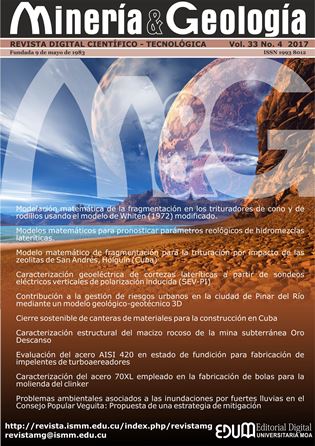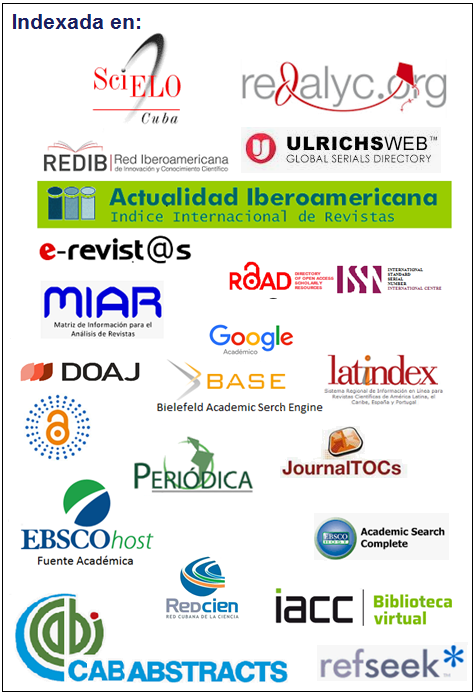Mathematical modeling of fragmentation in cone and roller crushers using modified Whiten's model (1972)
Keywords:
comminution, crushing, modeling, particles population balance method.Abstract
Crushing mathematical modeling using particles population balance method is a fundamental tool for process analysis, optimization and design. This paper deals with the evaluation of the fracture events and process in cone and rolls crushers. For that proposes, is taken as reference Whiten (1972) structural model modifying fragmentation distribution function. This function was replaced by Austin and Luckie (1972) expression. For model development, was created an algorithm using Matlab 13a like determining resource of fractures parameters. Model estimated error for evaluated crushers established the viability of its use for modelling and simulation, particularly for rolls crushers that even before were simulated by simple fragmentation models. Classification and fragmentation distribution functions obtained, describe the events and process fracture essentials that take place in both crushers.Downloads
References
AUSTIN, L. G. & CONCHA, F. 1994: Diseño y simulación de circuitos de molienda y clasificación. CYTED. Programa Iberoamericano de Ciencia y Tecnología para el Desarrollo. Subprograma de Tecnología Mineral. Red de Fragmentación XIII-A.
AUSTIN, L. G. & LUCKIE, P. T. 1972: Estimation of non-normalized breakage distribution parameters from batch grinding. Powder Technol 5: 267–277.
AUSTIN, L. G.; VAN ORDEN, D. R. & PÉREZ, J. W. 1980: A preliminary analysis of smooth roll crushers. International Journal of Mineral Processing 6: 321–336.
AUSTIN, L. G.; VAN ORDER, D. R.; MC WILLIAMS, B. & PÉREZ, J. M. 1981: Breakage parameters of some materials in smooth roll crushers. Powder Technology 28: 245-251.
BROADBENT, S. R. & CALLCOTT, T. G. 1956: A matrix analysis of processes involving particle assemblies. Phil. Trans Royal Soc. Lond. Ser. A. 249(960): 99–123.
COELLO-VELÁZQUEZ, A. L.; MENÉNDEZ, A. J. M. & LABORDE, B. R. 2008: Grindability of lateritic nickel ores in Cuba. Powder Technology 182: 113–115.
COELLO-VELÁZQUEZ, A. L.; MENÉNDEZ-AGUADO, J. M.; HECHAVARRÍA-PÉREZ, J. R.; SÁNCHEZ, A. B. & ÁLVAREZ, B. 2011: Toward the determining the behaviour of de fragmentation functions during the impact crushing of minerals. Mineral and metallurgical processing 28(2): 82-86.
DENIZ, V. 2003: The effect of the fraction mill critical speed on kinetic breakage parameters of clinker and limestone in laboratory ball mill. Snd. International Mining Congress and Exhibition of Turkey-IMCET. ISBN-975-395-603-3.
HECHAVARRÍA, J. R.; COELLO, V. A.; MENÉNDEZ, J. M. & LABORDE, R. 2008: Aplicación de los modelos de Nikolov en la trituración por impacto de la mineral zeolita del yacimiento San Andrés, Holguín. Minería & Geología 24(4).
KELLY, E. G. & SPOTTISWOOD, D. J. 1990: The breakage function, what is it really? Minerals Engineering 3(5): 405-414.
KWON, J.; CHO, H.; MUN, M. & KIM, K. 2012: Modeling of coal breakage in a double-roll crusher considering the reagglomeration phenomena. Powder Technology 232: 113–123.
LABORDE, R. 2005: Modelación y simulación matemática de la molienda del mineral laterítico con composición substancial compleja. Tesis doctoral. Alfredo L. Coello Velázquez & Juan María Menéndez Aguado (Tutores). Instituto Superior Minero Metalúrgico de Moa.
LEWIS, F. M. & HORST, W. E. 1980: Comminution-classification-screening. In: Weiss, N. (ed). SME Mineral Processing Handbook. SME, NY.
LEYVA-MORMUL, A.; COELLO-VELÁZQUEZ, A. L.; HECHAVARRÍA-PÉREZ, J. R.; MENÉNDEZ-AGUADO, J. M.; LEYVA-GONZÁLEZ, O. S. & LEYVA-RAMÍREZ, E. 2015: Modelo de Whiten (1972) modificado para modelación de la trituración de la antracita residual de Nicaro. Minería & Geología 31(1): 13-28.
LYNCH, J. A. 1980: Circuitos de trituración y molienda de minerales. Editorial Rocas y Minerales, Madrid.
NIKOLOV, S. 2002: A performance model for impact crusher. Minerals Engineering 15: 715–721.
NIKOLOV, S. 2004: Modelling and simulation of particle breakage in impact crushers. Int. J. Miner. Process. 74: 219–225.
POLE, F. M. 2005: Caracterización de la preparación mecánica de las zeolitas naturales de Caimanes. Coello-Velázquez, A. & Menéndez-Aguado, J. M. (Tutores). Tesis de maestría. Instituto Superior Minero Metalúrgico de Moa.
REID, K. J. 1965: A solution to the batch grinding equation. Chemical Engineering Science 20(11): 953-963.
SONI, S. K.; SHUKLA, S. CH. & KUNDU, G. 2009: Modeling of particle breakage in a smooth double roll crusher. International Journal of Mineral Processing 90(1): 97-100.
STAMBOLIADIS, E. T. 2002: A contribution to the relationship of energy and particle size in the comminution of brittle particulate materials. Mineral Engineering 15(10): 707-714.
TAGGART, A. F. & BEHRE, H. A. 1945: Handbook of mineral dressing, ores and industrial minerals. John Wiley & Sons.
WHITEN, W. J. 1972: The simulation of crushing plants with models developed using multiple spline regression. Journal of the South African Institute of Mining and Metallurgy 72(10): 257.
WILLS, B. & FINCH, J. 2016: Mineral Processing Technology: An Introduction to the Practical Aspects of Ore Treatment and Mineral Recovery. Eighth Edition. Elsevier Ltd, London, 496 p.
WILLS, B.; NAPIER-MUNN. 2006: Mineral Processing Technology: An Introduction to the Practical Aspects of Ore Treatment and Mineral Recovery. Seventh Edition. Elsevier Ltd, London, 450 p.
Published
How to Cite
Issue
Section
- Authors retain copyright and guaranteeing the right magazine to be the first publication of the work as licensed under a Creative Commons Attribution-NonCommercial that allows others to share the work with an acknowledgment of the work's authorship and initial publication in this journal.
- Authors may establish separate supplemental agreements for the exclusive distribution version of the work published in the journal (eg, place it in an institutional repository or publish it in a book), with an acknowledgment of its initial publication in this journal.
- Authors are allowed and recommended to disseminate their work through the Internet (e.g., in institutional telematic archives or on their websites) before and during the submission process, which can produce interesting exchanges and increase citations of the published work. (See The effect of open access)




